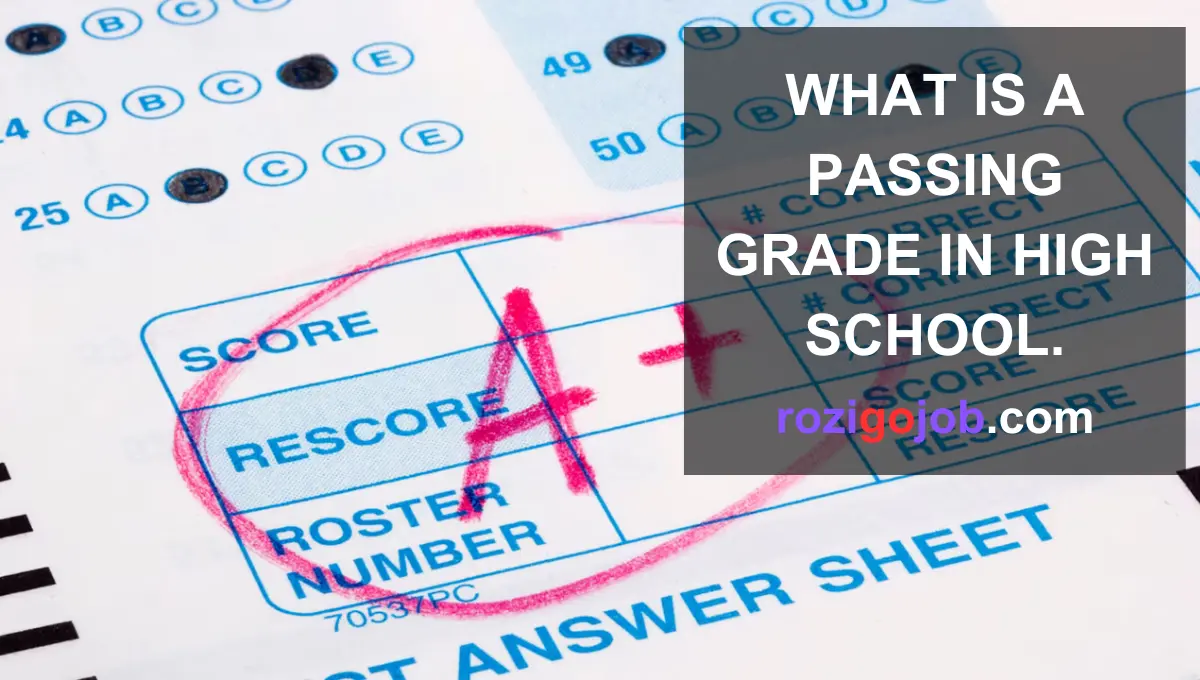What Is A Passing Grade In High School.
Grades are a key factor in high school academic performance. What makes a passing grade in high school, though, may be a question that many students and parents have. Depending on the school, district, and even the state, the response to this query may change.

This article will examine the notion of a passing grade in high school and the variables that may affect it.
What Is A Passing Grade In High School?
In high school, a passing grade is often one that satisfies the minimal standards for receiving credit in a given course. A D or better is often considered a passing grade, while some schools have a C or higher requirement. It’s crucial to remember that a passing grade does not always imply that a student has mastered the material. A student who receives a passing mark might not fully comprehend the subject presented in the course and might have trouble in more challenging curriculum.
Different Grading Systems:
The grading scheme adopted by the school or district might have an impact on what constitutes a passing grade in high school. Some schools employ a conventional grading scheme in which letter grades are given according to a point or percentage scale. An A could be awarded for a score of 90 to 100%, a B for 80 to 89%, and so on. A D or above qualifies as a passing grade under this system.
Other schools may employ a standards-based grading scheme, where grades are determined by how well students have mastered particular standards or learning objectives. In this approach, students could have to prove they are proficient in each standard to a particular degree in order to pass. To pass a course, students can occasionally need to demonstrate mastery of all requirements.
Depending on their performance, students may pass or fail a course at some schools that employ a pass/fail grading system. In this system, there is no differentiation between various levels of performance; a passing grade is just a passing mark.
Minimum Requirements For Graduation:
The minimal standards needed to graduate from high school are another aspect that may affect what qualifies as a passing grade there. Most of the time, in order to graduate, students must get a predetermined amount of credits in a given field of study. For instance, a school could mandate that students complete four credits in English, three in math, two in science, and so on.
In order to receive credit for a course, students normally need to achieve a passing grade. For some courses, greater grades can be needed according to various schools. For instance, a school may stipulate that in order to graduate, a student must have a C or above in each of the four core subjects—English, math, science, and social studies.
College Requirements:
The notion of a passing grade might be considerably more complicated for kids who intend to go to college after high school. In order to be considered for admission, colleges often need applicants to have a minimum GPA (Grade Point Average). Based on the grades received in high school courses, this GPA is determined.
A minimum grade may be required by some universities in order to receive credit for a given course. For instance, a college can demand that students receive a C or above in every course that counts toward a specific major.
In addition, many institutions have prerequisites for admission that students must complete in high school. Specific grade criteria, such as achieving a B or above in every math course, could apply to these courses.
In conclusion, the definition of a passing grade in high school might change based on the grading system in use, the graduation criteria, and the college requirements. In general, a passing grade is one that satisfies the minimal standards for receiving credit in a certain subject. It’s crucial to keep in mind that a passing grade does not always imply that a student has mastered the material. High school students who want to succeed should seek to increase their level of comprehension and competency in their studies.
While the minimum grade required to finish a high school course may vary significantly from state to state, or even from district to district, in general, students must receive at least a 60% or a D-. It’s crucial to remember that this benchmark might change and that some professors or institutions might set higher standards for passing.
Additionally, the passing mark may vary depending on the grading system used by the institution, which may use a 1-4 scale or a percentage-based system. To make sure they are fulfilling the requirements for moving on to the next grade level, students must be aware of their school’s grading policy and passing standards.
Recognizing that completing a class is not the only prerequisite for graduation is equally crucial. Students must often fulfill particular credit requirements at high schools in order to graduate. These prerequisites may include attaining a minimum GPA and finishing a predetermined number of courses in a given area, such as math, science, or English.
Students should strive to achieve their best in all of their classes, regardless of the passing grade, even if passing grades are important to keep on track toward graduation. Students who perform well in school may be eligible for scholarships, entrance to colleges, and potential employment prospects. The development of study habits and critical thinking abilities that will be useful in college and beyond should also start in high school.
Conclusion:
A D- or a 60% is often considered a passing grade in high school, however this might change based on the institution and grading scheme. It’s vital for students to grasp their school’s passing standards and credit requirements to stay on track towards graduation. In the end, high school is a crucial period for kids to build the abilities and routines that will position them for success in their future undertakings.
You should also read about







